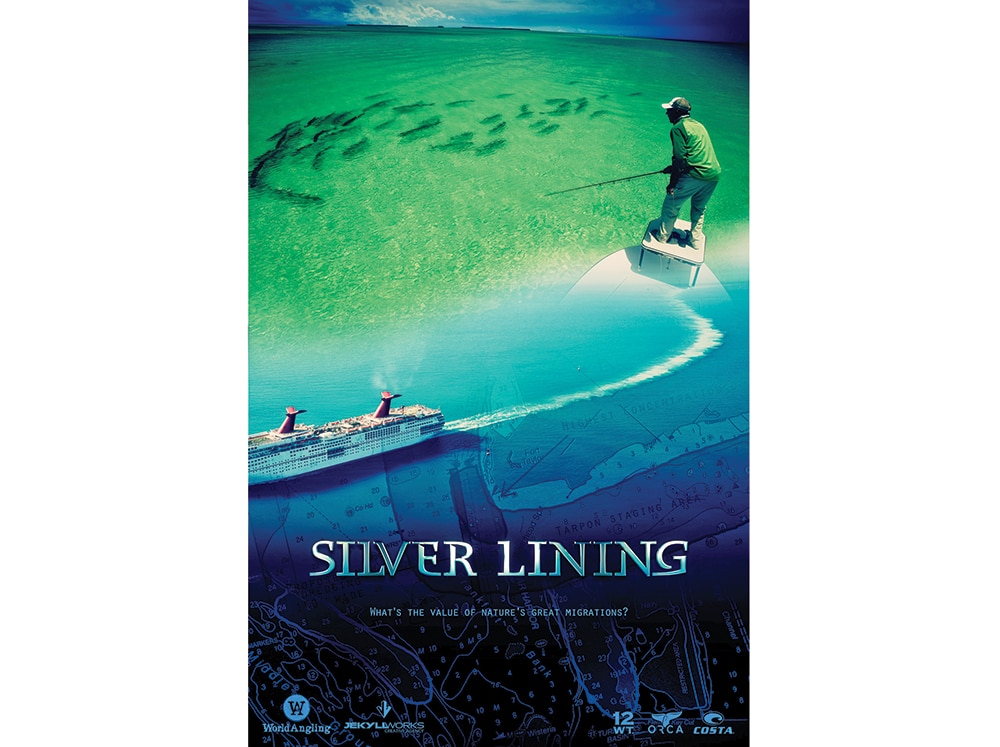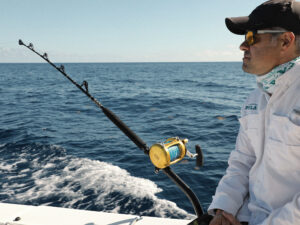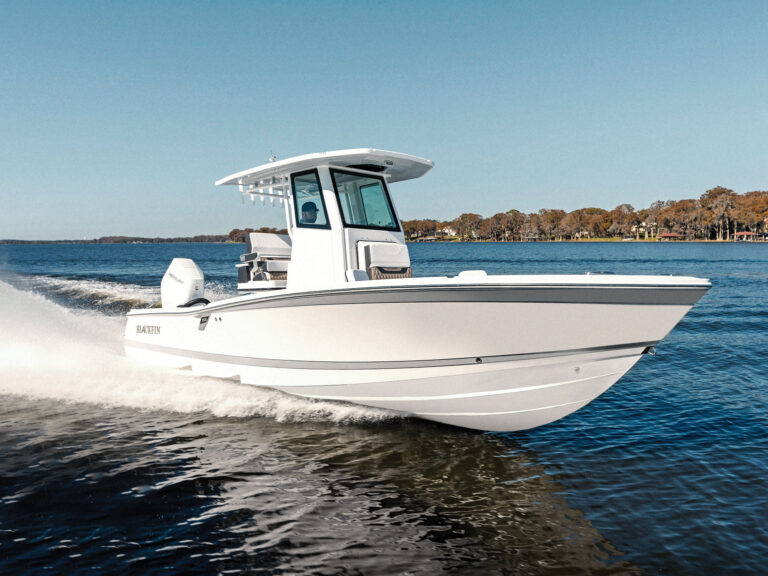
[Be sure to click through all the images in the gallery above.]
If you hit it right, Key West can be one of the best tarpon fisheries in the world. That becomes apparent in the opening of a new short film written and produced by Key West guide and filmmaker Capt. Will Benson. Silver Lining opens on a windless flat-calm morning as large fish roll as far as the eye can see. The images are breathtaking. Anglers hoot over screaming reels and holes left in the water by leaping chrome-plated monsters. Some of the best tarpon action I’ve ever seen. Yet the tone quickly changes as large cruise ships enter the scene. Filmed from above, they are shown trailing huge silt plumes as giant props blow sediment from the seafloor into the water column in Key West Harbor.
Key West’s year-round tropical climate, its unique geography, its expansive reef system and the abundance of life that depends on those reefs are what make its tarpon fishery so extraordinary. The harbor’s deep water serves as a staging point for an amazing annual tarpon migration. Those fish come up into the adjacent flats to feed, offering fly-rodders an exceptional opportunity to target them. Yet, as is too often the case, such ecosystems are fragile and easily disrupted by the heavy hand of man. Corals, sea grass and other marine plant and animal life found on the seafloor depend on sunlight for photosynthesis. If the sunlight is blocked, it doesn’t take a scientist to figure out what happens. There’s a general consensus among anglers that continued disturbance of the silt has led to continued degradation of Key West’s tarpon flats.
The Florida Keys are part of a federally and state protected marine sanctuary and host the only barrier reef in the United States. Just about everything within this marine sanctuary is protected, including the seafloor. Thus, when a recreational boater damages sea grass on even a small scale, that boater could face state and federal penalties. So, it’s hard to understand why the cruise ship industry is not held liable under the same laws.
Key West Harbor was last dredged in 2005. A great number of corals, sponges and sea fans were removed; that loss of natural filtering systems compounded the siltation problem. Anglers experienced a simultaneous decline in the number of tarpon and noticeably shorter tarpon season. The tarpon fishing survived the 2005 dredging, but there is a new, forceful push to implement a much larger channel-widening/dredging project that would accommodate the cruise ship industry’s latest and largest cruise ships, which require greater maneuverability to pull into Key West. Benson says there are about 40 ships in the Caribbean basin; Royal Caribbean is the only company that has “megaships,” and only three of them are too long and draw too much water to fit in the current ship channel. If the channel is not widened, those three ships will not stop in Key West, but every other liner can still use the harbor.
For better or worse, Key West has become dependent on the cruise ship business. I’ve been there when what seemed like a quiet town immediately became crowded like Disney World after a cruise ship pulled in. Hotel owners note that the hordes of cruise ship passengers make the Key West experience less enjoyable for their guests, who spend far more money than do cruise ship passengers. Those guests aren’t coming back because of the amusement-park-like atmosphere. Property owners don’t like cruise ships, arguing that they degrade the local quality of life. But cruise ship proponents say that the city stands to lose jobs and at least $70 million in annual revenue and fees; bars and restaurants, tour-guide operators and T-shirt shops all stand to lose business if the cruise industry is curtailed.
One can’t ignore the fact that cruise ships negatively impact the historically important charter fishing industry, which is of huge economic importance to the Florida Keys as well as the entire state of Florida; charter fishing has a $7.5 billion economic impact in the state and sustains 80,000 jobs. Diving and other eco-tourism has a similar financial impact. If cruise ships materially impair the natural resources that support those industries, which have brought visitors to Key West for more than a century, it is entirely possible that Key West will become unattractive to tourists and that, at some point in the future, even the cruise ships won’t visit anymore. When the potential gain from the proposed dredging is weighed against the potential harm to Key West’s traditional tourist industries, the risk/reward analysis would seem to favor the status quo.
After years of contentious debate, late last year the City Commission opted to duck responsibility for the politically charged decision and called for a public referendum, scheduled for next fall. That will allow the residents of Key West to decide whether the town should commission a three-year, $3 million feasibility study from the Army Corps of Engineers to analyze the pros and cons of widening the main channel. A 2011 $100,000 reconnaissance study by the Army Corps of Engineers concluded that a “significant federal interest in national water policy and economic development exists for navigation improvements to the Key West Harbor.” That study put the price tag at about $36 million.
All this said, when big money and lobbyists in Washington are involved, unexpected things can happen, so many fishing guides remain concerned. The Lower Keys Guides Association has taken a public stance against channel widening and is working to educate the public and convince politicians that dredging is not worth the potential environmental and financial impact.
Key West has certainly developed an economic dependence on cruise ships; Benson’s film asks why we can’t also recognize the value of natural resources and strike a balance between the two. It’s unlikely that Key West’s economy will collapse if Royal Caribbean’s three mega cruise ships don’t stop there, but much of what makes Key West special will die if its unique marine ecosystem is seriously harmed. It comes down to the kind of legacy we want to leave: tacky T-shirt shops or an extraordinary marine ecosystem that supports the awesome congregations of tarpon that amass here.
Millions of taxpayer dollars should not be used to destroy marine habitat so that a minority of businessmen can make a quick buck. It would be better to spend those dollars on existing technology that can restore reefs that have been lost. That would also benefit Key West businesses now, while preserving a special and rare ecosystem intact to benefit other people in years to come.
“We have a decision,” Benson says. “What do we want to stake our future on — the amazing shallow-water ecosystem, which is why folks come here, or are we going to take a gamble on an industry that doesn’t care what tracks it leaves?”
Judge Dredge
Even if the town votes in favor of the channel widening, it would be only a first step. Because Key West is part of the Florida Keys Marine Sanctuary and the Key West and Great White Heron national wildlife refuges, the ultimate decision has to take into account the area’s historical uses, along with the original purpose and goals surrounding such designations. Any dredging would require Congressional approval. I expect the town and cruise ship industry would have a difficult time overcoming the ban on dredging in Key West’s National Marine Sanctuary; even getting a study approved by Congress, particularly this Congress, would probably take years.
The $1.5 million required for the federal study would have to be included in an appropriations bill. In addition to the initial appropriation, the project would have to be included in a federal WRDA (Water Resources Development Act), and no WRDA has passed since 2007. The remaining $1.5 million would need to be paid for by the state of Florida and the cruise ship industry. Even after appropriations, it is unlikely that any study would win dredging interests an exception to the federal sanctuary rules.
** See For Yourself**
Lower Keys guide Capt. Will Benson’s passion for his home water and the fish that inhabit it is apparent in all of his films. We can all certainly get behind fly-fishing films with unique story lines and strip sets timed perfectly with the drumbeat of an energetic tune. Benson’s projects all have a selfless purpose that excites, inspires and encourages. While some are more lighthearted than others, Silver Lining’s purpose is one that all of us need to be aware of. The film was originally created for the 2013 Fly Fishing Film Tour and can now be viewed at worldangling.com by clicking on the videos tab.
Or view the video below:














